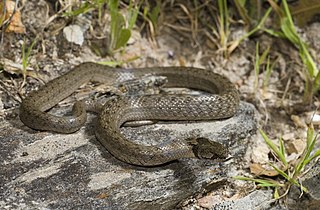
Boiga is a large genus of rear-fanged, mildly venomous snakes, known commonly as cat-eyed snakes or simply cat snakes, in the family Colubridae. Species of the genus Boiga are native to southeast Asia, India, and Australia, but due to their extremely hardy nature and adaptability, have spread to many other suitable habitats around the world. There are 38 recognized species in the genus. According to the study done by Jiří Smíd regarding Old World cat snakes, the ancestor of the cat snake originated in Africa, from where it diversified and expanded to other countries. Despite this diversity however, the different species have very similar needs in terms of temperature and precipitation.

The boomslang is a large, highly venomous snake in the family Colubridae.

Spilotes sulphureus, commonly known as the yellow-bellied hissing snake or Amazon puffing snake, is a species of snake in the family Colubridae. The species is found in South America, as well as the Caribbean island of Trinidad.
Boiga dightoni, commonly known as Dighton's catsnake, the Pirmad cat snake, and the Travancore cat snake, is a species of rear-fanged mildly venomous snake in the family Colubridae. The species is endemic to the Western Ghats of India.
Psammophis leithii, commonly called the Pakistan sand racer, Pakistani ribbon snake, or Leith's sand snake, is a species of rear-fanged snake in the family Psammophiidae. The species is native to South Asia. It is harmless to humans.

Trachischium is a genus of snakes, known commonly as slender snakes or worm-eating snakes, in the subfamily Natricinae of the family Colubridae. The genus is endemic to Asia.

The Colubrinae are a subfamily of the family Colubridae of snakes. It includes numerous genera, and although taxonomic sources often disagree on the exact number, The Reptile Database lists 717 species in 92 genera as of September 2019. It is the second largest subfamily of colubrids, after Dipsadinae. Many of the most commonly known snakes are members of this subfamily, including rat snakes, king snakes, milk snakes, vine snakes, and indigo snakes.

Lycodon is a genus of colubrid snakes, commonly known as wolf snakes. The Neo-Latin name Lycodon is derived from the Greek words λύκος (lykos) meaning wolf and οδόν (odon) meaning tooth, and refers to the fang-like anterior maxillary and mandibular teeth. They are nonvenomous, but many members of this genus strongly resemble the venomous kraits in appearance, an example of Emsleyan mimicry.

Macroprotodon is a genus of snakes in the family Colubridae. All of the member species of the genus are commonly known as false smooth snakes.

Telescopus, the Old World catsnakes, is a genus of 12 species of mildly venomous opisthoglyphous snakes in the family Colubridae.

Hoplocephalus is a genus of venomous snakes in the family Elapidae. The genus is endemic to Australia. Three species are recognized.

Amblyodipsas is a genus of snakes found in Africa. Currently, 9 species are recognized. These snakes are often known as purple-glossed snakes or glossy snakes. Although rear-fanged, all species are considered harmless, but their venom has not been well studied. They should not be confused with the glossy snakes of the genus Arizona, which are found in North America.

The twig snakes, also commonly known as bird snakes or vine snakes, are a genus of rear-fanged venomous snakes in the family Colubridae. The genus is native to Africa. All species in the genus have a slender and elongated profile, a long tail, a narrow head and a pointed snout. The eye of all species has a horizontal pupil, shaped like a keyhole, which gives twig snakes binocular vision. Twig snakes are greyish-brown with faint light and dark markings. When threatened, they inflate the throat to display bold black markings between the scales. Twig snake bites are potentially deadly: the venom is hemotoxic, affecting the blood clotting mechanism and causing uncontrolled bleeding and internal hemorrhaging. Bites by twig snakes have caused death in humans; famous herpetologist Robert Mertens died after being bitten by his pet savanna vine snake. However, envenomed bites are extremely rare when not handling the snake, as the fangs can't breach the skin except in a few places like the web between the thumb and fingers.

Tachymenis is a genus of venomous snakes belonging to the family Colubridae. Species in the genus Tachymenis are commonly known as slender snakes or short-tailed snakes and are primarily found in southern South America. Tachymenis are rear-fanged (opisthoglyphous) and are capable of producing a medically significant bite, with at least one species, T. peruviana, responsible for human fatalities.
Rhabdophis ceylonensis is endemic to the island of Sri Lanka. The species is commonly known as the Sri Lanka blossom krait, the Sri Lanka keelback, and මල් කරවලා or නිහලුවා (nihaluwa) in Sinhala. It is a moderately venomous snake.

Lytorhynchus is a genus of snakes of the family Colubridae.

The large-eyed green tree snake, also known commonly as the splendid dagger-tooth tree snake, is a species of venomous snake in the family Colubridae. The species is endemic to Africa. There are three recognized subspecies.
The spotted dagger-tooth tree snake is a species of venomous snake in the family Colubridae. The species is indigenous to Middle Africa.

Ialtris is a genus of snakes in the subfamily Dipsadinae of the family Colubridae. The genus is endemic to the island of Hispaniola.















